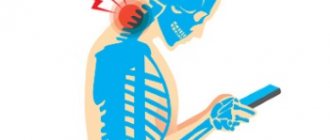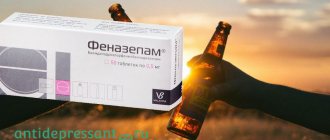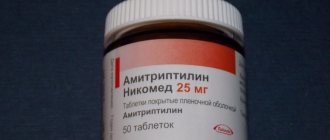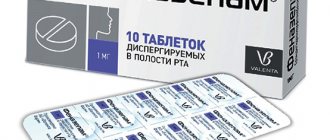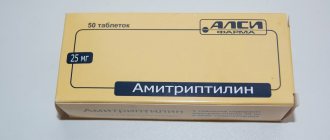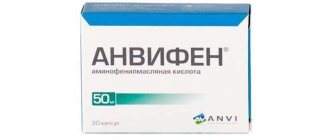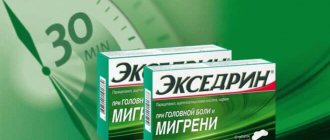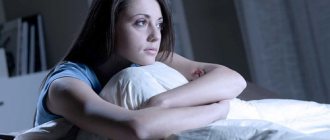Effect of anxiolytics on the nervous system
The term “anxiolytics” is literally translated from Latin as the dissolution of an anxious state.
Anxiolytic drugs are included in the group of tranquilizers, otherwise they are designated as “minor tranquilizers”, “ataractics”, anti-neurotic and psychosedative drugs. Anxiolytics lead to “calmness” in those areas of the brain that are responsible for emotions. Some medications also lead to relaxation of the skeletal muscles; they have a muscle relaxant effect on the striated muscles. When using anxiolytics to treat people with vegetative-vascular dystonia, they achieve:
- reducing anxiety and fear;
- reducing emotional instability and tension;
- eliminating obsessive thoughts, phobias and hypochondria;
- reducing excitability.
A number of anxiolytics are also endowed with hypnotic properties. With systemic use of drugs, falling asleep improves and sleep duration increases.
The muscle relaxant effect of drugs is considered positive in the treatment of vegetative-vascular disorders. Anxiolytics relieve mental and motor agitation. At the same time, such an effect of drugs may limit their use in patients whose work requires an immediate response.
Among the anxiolytic drugs used in the treatment of vegetative neuroses, benzodiazepine derivatives are used. In addition to the anti-anxiety effect, they have a sedative, anticonvulsant, muscle relaxant and mild hypnotic effect.
Anxiolytic drugs are divided as follows:
- long-acting drugs - Phenazepam, Medazepam;
- drugs with an average duration of the main effect - Lorazepam, Nozepam;
- minimally effective drugs – Midazolam.
Most of these drugs have side effects, such as increased drowsiness, weakness, and memory loss. Therefore, their use in the treatment of VSD is limited in some cases.
The following are endowed with a slight sedative, hypnotic and muscle relaxant effect:
- Dipotassium clorazepate;
- Tofisopam;
- Mebicar.
Therefore, these drugs are used as daytime tranquilizers.
Patients with VSD are mainly prescribed:
- Phenazepam;
- Grandaxin;
- Adaptol.
Treatment with these drugs over a long period leads to addiction and dependence. To prevent this from happening, the course of therapy should be minimal or intermittent, that is, stopping the medications for several days and then using them at the same dosage.
Anxiolytics suitable for their mechanism of action are prescribed initially in the smallest dosage, then it is gradually increased until a therapeutic effect is achieved. The dose reduction is also carried out gradually. These medications should only be taken as prescribed by your doctor.
Anxiolytics are incompatible with alcohol and can enhance the effect of other drugs. These drugs should be prescribed by a doctor, assessing all manifestations of VSD and the person’s psycho-emotional status.
What is it prescribed for, indications for use
The range of uses of the drug is quite extensive:
- this is premenstrual syndrome;
- mental adaptation disorders;
- alcohol withdrawal syndrome;
- for menopausal syndrome in combination with hormonal drugs or independently;
- cardialgia;
- neurogenic muscle atrophy, pathological conditions and neuroses;
- severe emotional stress, anxiety, autonomic disorders, apathy.
Grandaxin is also used in cardiology for the treatment of vegetative-vascular dystonia, as well as after a stroke.
The composition is a tranquilizer?
The main chemical is tofisopam, in Latin Tofisopam.
Grandaxin is a tranquilizer belonging to the group of benzodiazepine derivatives. Being a good psycho-vegetative regulator, it fights various autonomic disorders and has moderate stimulating activity.
This drug is a “daytime” tranquilizer, after taking it there is no feeling of drowsiness, lethargy or impaired consciousness. The drug does not relax muscles and does not have an anticonvulsant effect. However, when taking it, you should be careful when driving a car.
Analogs
Drugs with synonyms similar in action to Grandaxin:
- Atarax;
- Adaptol;
- Afobazole;
- Betaserc;
- Gidazepam;
- Tazepam;
- Afobazole;
- Mexidol;
- Neurol;
- Relanium;
- Phenazepam;
- Phenibut and many others.
Afobazole or Grandaxin, which is better?
Let's compare these similar medicines used in the treatment of similar diseases; Grandaxin is cheaper in price and is available with a prescription. Considering the similarity of the properties of these drugs and having analyzed reviews about them, we can conclude that Grandaxin acts a little more mildly and is approved for use by older people. However, patients note the number of side effects that appear as a result of taking it, more often than with Afobazole. Each of the above drugs has its own pros and cons, and the decision to prescribe them should only be made by a specialist. Moreover, a person is not able to diagnose a form of depression himself and cannot determine how severe his stress is. Choosing medications on your own can only harm your health.
Phenazepam
For patients with VSD, Phenazepam is prescribed if the disease is accompanied by:
- fears;
- increased anxiety;
- anxiety;
- panic;
- sleep disturbance.
Phenazepam is used both one-time to eliminate anxiety, and in a specially selected course. More often it is used in tablet form. The standard treatment regimen is 0.5 g (one tablet once a night). In case of severe disorders, the medicine is taken 3 tablets per day during the first days, then, after the main symptoms are relieved, they switch to a maintenance dose.
The above dosages, depending on the patient’s condition, can be reduced or increased by the doctor. Self-selection of the dose is fraught with increased anxiety or even confusion due to an overdose.
Phenazepam has an extensive list of contraindications. The drug is not prescribed:
- pregnant women;
- during lactation;
- children under 18 years of age;
- in a state of shock;
- with myasthenia gravis.
It is used with caution in depression and in the treatment of elderly people and patients after a stroke.
Grandaxin
The main active ingredient of Grandaxin is Tofisopam. The drug has an anti-anxiety effect. This feature of Grandaxin allows it to be prescribed to patients with VSD during the daytime.
The medicine does not lead to a deterioration in concentration and does not inhibit reactions, which makes it possible not to limit the use of anxiolytics for people working in transport and with complex mechanisms.
Long-term course use of Grandaxin does not cause addiction or withdrawal symptoms. The medicine stabilizes psychological balance and is used to prevent panic attacks.
Grandaxin is prescribed if VSD is accompanied by:
- fears, nervous tension, increased fatigue, lethargy, apathy;
- depressive reaction to stressful situations;
- increased nervous excitability of women during menopause;
- pain in the chest area;
- withdrawal syndrome.
Grandaxin is not used:
- if VSD occurs with severe manifestations of depression, unmotivated aggressiveness, psychomotor agitation;
- in the first three months of pregnancy;
- if symptoms of apnea are recorded, including sleep apnea;
- when taking medications for psoriasis;
- against the background of organic brain pathology (oligophrenia, encephalopathy).
Grandaxin is one of the best drugs for the treatment of vegetative neuroses. But the medicine can cause unwanted side reactions such as headaches, sleep disturbances, allergic reactions and digestive problems. To reduce the likelihood of their occurrence, the drug is taken in the dosage prescribed by the doctor. The evening intake of Grandaxin should be no later than 17:00.
